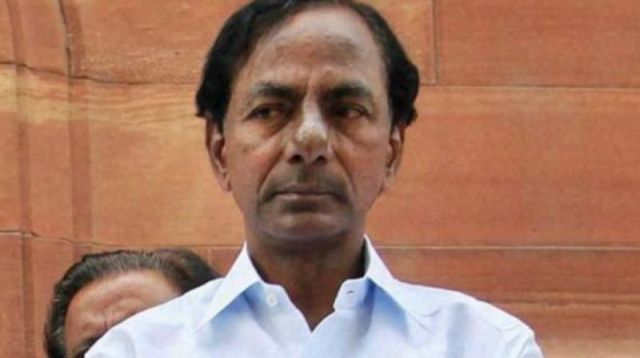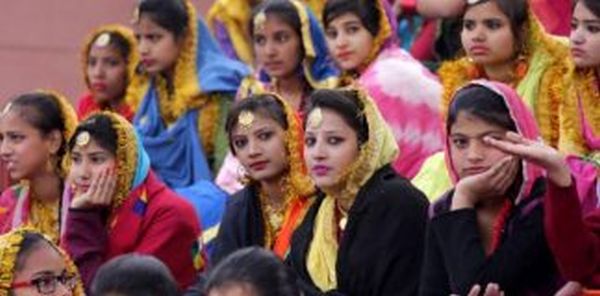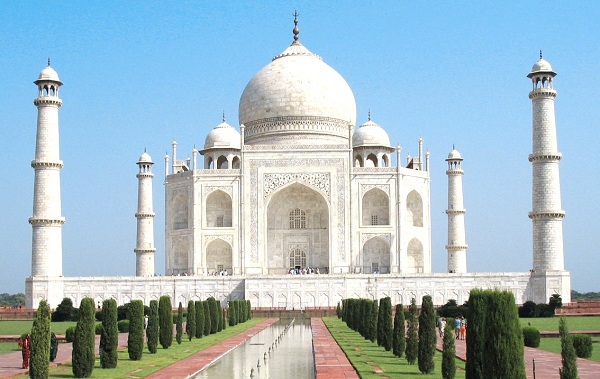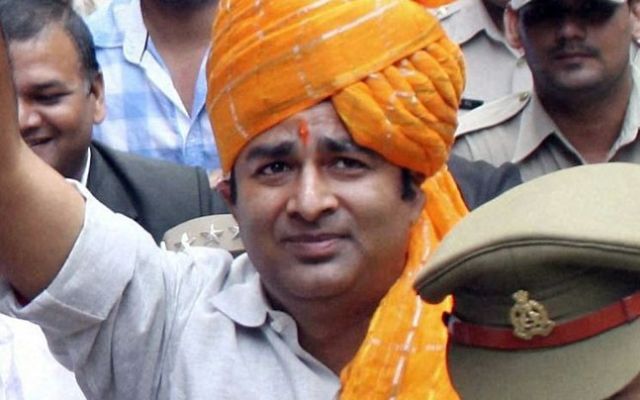
by admin | May 25, 2021 | News, Politics

Chief Minister K. Chandrasekhar Rao
Hyderabad : The Telangana government has decided to develop an exclusive industrial estate and IT corridor for Muslims.
The decision was taken on Monday by Chief Minister K. Chandrasekhar Rao at a meeting with senior officials and Muslim leaders.
It was also decided to construct the Hyderabad International Islamic Cultural Convention Centre on 10 acres of land in Kokapet here. The Chief Minister directed that work on the project should commence in three weeks.
According to a statement from the Chief Minister’s Office, Charminar and its surrounding area will be developed like the Golden Temple in Amritsar.
KCR, as the Chief Minister is popularly known, said a 42 km stretch along the Musi river will be developed like the Sabarmati riverfront in Gujarat. He asked officials to make arrangements for plying metro and nano rail along the Musi riverbank.
Deputy Chief Minister Mahamood Ali, Ministers K.T. Rama Rao and Etela Rajender, AIMIM President and Hyderabad Member of Parliament Asaduddin Owaisi, AIMIM Legislature party leader Akbaruddin Owaisi, state Chief Secretary S.P. Singh, Government Advisor A.K. Khan and other senior officials attended the meeting.
KCR said all the development schemes initiated by the government should benefit the minorities. For the self-employment of the minority youth, subsidy to units worth Rs one lakh to Rs 2.5 lakh will be given without having any link with the banks.
The Chief Minister said that minorities should have 10 per cent quota in the double bedroom housing scheme.
Also, tests for recruitment to government jobs will be conducted in the Urdu language along with English and Telugu.
Asaduddin Owaisi lauded the residential schools set up by the state government for minorities and said this would bring a revolution in the next 10 years.
—IANS

by admin | May 25, 2021 | Entrepreneurship, News, Social Entrepreneur, Women Entrepreneur

Musharraf at her sanitary producing unit in Kupwara (left) // Mubeena Khan, a Kashmiri entrepreneur, at her sanitary napkin manufacturing unit in border district of Kupwara. (Photo credit: IANS)
By Sarwar Kashani,
Kupwara, (Jammu and Kashmir) : Growing up in a society that stigmatises menstruation, two women social entrepreneurs in this border village of Jammu and Kashmir are battling the taboos attached to what is a routine biological process. They are not only creating awareness but also manufacturing and selling sanitary napkins to help poorer women who cannot afford branded products.
Mir Musharraf, 18, and Mubeena Khan, 25, who grew up in an orphanage here, began their entrepreneurial journey two years ago, knowing well the arduous task they had chosen for themselves.
“We have experienced what women in Kashmir, particularly in the border and rural areas, go through during their periods. It’s not only about the stigma, it is also about hygiene during periods,” Mir told IANS.
Khan added: “It was never going to be easy. We knew that. Talking about menstruating is not easy even with women in Kashmir. But we wanted to defeat the stigma.”
Mir, who originally hails from Keran village, some 100 km north of state capital Srinagar, lost her father, a farmer, to blood cancer when she was still young. Keran, the last village of the eponymous border sector on the Line of Control (LoC) that divides Jammu and Kashmir between India and Pakistan, has often faced the brunt of military skirmishes between the armies of the two countries.
Mir’s family had to relocate to Kupwara in the early 1990s after frequent heavy cross-border firing ripped the village apart. That was when militancy in the Kashmir Valley was at its peak and Pakistan was actively pushing armed insurgents into the Indian side under cover of border firing.
After her husband’s death, Mir’s mother had no other means of income to sustain the family. She got her daughter admitted to Basaira-a-Tabasum, an orphanage in Kupwara town run by Borderless World Foundation, a Pune-based non-governmental organisation that helps with the socio-economic development of people in border areas.
At the orphanage, Mir became friends with a “like-minded” Khan, who had also lost her father when she was just two-and-a-half.
The girls grew up in the orphanage that not only sheltered and fed them but also equipped them with entrepreneurial skills to be the agents of socio-economic changes in Kupwara — an area where an estimated 40 per cent of the population lives below the poverty line.
Remembering their days in the orphanage, both Mir and Khan recalled how they used to talk for hours daily, planning what they wanted to do in their lives.
“I always wanted to do something for women, particularly those living in border areas. But I had not imagined even in my dreams that I would be talking about menstruation so openly, leave aside producing sanitary napkins,” Mir said.
“Actually, Mubeena came up with the idea and you know why,” she asked matter-of-factly.
Khan had always felt perplexed about the treatment women got during their menstrual cycles. They are not allowed inside kitchens, they are not allowed to pray, they become untouchables during their periods.
“The most difficult battle in the war against such evils was with ourselves. We, as women, too believe in the traditions and it is very, very difficult to break the norm. And believe me, many girls drop out of schools because of this,” Khan, whose village, Helmatpora, also lies on the LoC, told IANS.
And equally important was making women aware about hygiene and other health issues associated with periods. Hundreds of studies have conclusively revealed that the practice of using cloth during periods is associated with very high risk of cervical cancers.
“When we get our first period, our mothers generally hand us a bunch of rags with strict instructions that we should not talk about it openly and stay away from the rest of the family,” she said.
“Imagine when we set out to talk about this openly. I remember how people, in fact girls, used to whisper about our ‘shamelessness’. But nothing would stop us.”
The two girls have conducted hundreds of awareness camps in schools, colleges and community centres talking about the issue.
The next step was their own self-empowerment and the empowerment of as many women as possible in their extended neighbourhood.
Eventually, they spoke with the Borderless World Foundation and shared the idea of setting up a cost-effective sanitary napkin manufacturing unit in Kupwara.
They began researching on the Internet, reading about their proposed business — before travelling to NIRMA Industries training centre in Solapur, Maharashtra, where they were incubated for three months and taught how to handle machines, grinders and other nitty gritty of the business by experts.
The real challenge was to raise the money needed for investment and also working capital. Iqra Javed, project officer with the Borderless World Foundation in Srinagar, said the foundation itself invested nearly Rs 12 lakh (Rs 1.2 million) to set up and run the unit.
Apart from this, the foundation helped them win Rs 300,000 as investment at a 2016 start-up competition by the Tata Institute of Social Sciences and Chinar Internationals, a Srinagar-based NGO helping start-ups.
And finally came the time to make a “Happy Choice” — the name they gave to their business unit. Machines and raw material were brought and the unit was set up at the Borderless World Foundation-run women development and social-entrepreneurship centre, Rah-e-Niswan, in a shanty structure in Solkute, 6 kms from Kupwara town.
The plan was to start production at the Solkute centre and establish a supply chain to distribute the product to other villages of the district.
“It was a 24-hour job. Right from the production purchases to the product, and then marketing, was all done by the two of us,” Mir said. “It was a challenge worth taking, though it took a heavy toll on us.”
The production rate was 250 packs of six pieces each a day. Each pack was sold at Rs 26 — against an average market price of Rs 35. A profit margin of Rs 16 was still significant.
Their lives got better and they started contributing to their family incomes and came the basic essentials like kitchenware, flooring and clothes for their mothers and siblings.
But the sales dipped after a while. The product and its packaging did not match market standards. “Happy Choice” did not have flaps that fold over the sides to help prevent the fluid from leaking. The packaging in an ordinary polythene cover with a sticker attached was also below standard.
To improve, they needed a packaging machine and a machine that would make and attach wings to the pads. But it would mean another investment of about Rs 900,000. Starved of funds, the two had to temporarily close their unit and have set out on an investment hunt.
“So far nobody has come forward. But we will keep striving till we get it. And we are sure — it is about ‘when’ not ‘if’,” Mir said.
But the awareness campaign is on. “We will keep talking about menstruation till everybody talks about it without attaching a taboo,” Khan intervened. “The battle is on. We have not lost it. We have paused it.”
(This feature is part of a special series that seeks to bring unique stories of ordinary people, groups and communities from across a diverse, plural and inclusive India and has been made possible by a collaboration between IANS and the Frank Islam Foundation. Sarwar Kashani can be contacted at sarwar.k@ians.in)
—IANS

by admin | May 25, 2021 | News, Politics
 Lucknow : In a damage control exercise after a BJP MLA’s comments on the Taj Mahal sparked outrage, Uttar Pradesh Chief Minister Yogi Adityanath on Tuesday said the famed monument in Agra was a part of Indian heritage.
Lucknow : In a damage control exercise after a BJP MLA’s comments on the Taj Mahal sparked outrage, Uttar Pradesh Chief Minister Yogi Adityanath on Tuesday said the famed monument in Agra was a part of Indian heritage.
Adityanath also told the media that the 17th century marble monument, built by Mughal emperor Shah Jahan for his wife Mumtaz Mahal, was constructed “by the blood and sweat of Indian labourers”. An official said the Chief Minister will also visit the Taj.
“It does not matter who built it and for what reason. It was built by the blood and sweat of Indian labourers,” Adityanath said of the Taj, India’s biggest tourist draw.
“Taj Mahal is a part of India’s heritage,” he went on. “Taj Mahal, Red Fort are all part of India’s heritage.”
The statement came after Uttar Pradesh BJP legislator Sangeet Som called the Taj Mahal a blot on Indian culture and said it was built by an emperor who wanted to finish off Hindus.
“We should not focus on Som’s statement,” the Chief Minister said, in the clearest sign that his Bharatiya Janata Party government in Uttar Pradesh was distancing itself from the MLA’s controversial remarks.
Adityanath said the Taj was important for the Uttar Pradesh government, specially “from the tourism perspective” and “it is our priority to provide facilities and safety to tourists there”.
Adityanath is scheduled to visit the Taj Mahal, Agra Fort, Fatehpur Sikri and other important monuments in Agra on October 26, an official told IANS.
Considered one of the seven wonders of the world, the Taj attracts millions of Indian and foreign tourists every year.
Last month, the Uttar Pradesh government had omitted references to the Taj in a booklet published to mark six months of the Adityanath government.
This drew sharp criticism, prompting Tourism Minister Rita Bahuguna Joshi to say that that Taj Mahal was of great importance to the state government and to the nation.
—IANS

by admin | May 25, 2021 | News, Politics

BJP leader Sangeet Som
Noida : BJP leader Sangeet Som has triggered controversy by saying the Taj Mahal is a “blot” on Indian culture and misquoted history by saying that Shah Jahan, builder of the 17th century marble mausoleum, had jailed his father and wanted to wipe out Hindus from the country.
The remarks by the Sardhana MLA in Meerut came after the Uttar Pradesh government removed the Taj Mahal from the list of attractions in its tourism booklet.
“Many people were disappointed that the Taj Mahal was removed from the UP tourism booklet. What history are we talking about? Whose history?
“The creator of the Taj Mahal (Shah Jahan) imprisoned his father. He wanted to wipe out all Hindus from India. If these people are part of our history, then it is very unfortunate.
“I guarantee you that we will change this history,” Som was shown saying in an undated viral video, apparently addressing a public gathering.
TV reports said the BJP leader was addressing a gathering in Meerut.
Som wrongly quoted history saying Mughal Emperor Shah Jahan had jailed his father. It was Shah Jahan’s son Aurangzeb who had dethroned and jailed his father inside the Agra Fort.
The Taj, one of the Seven Wonders of the World and a UNESCO World Heritage site, was built by Shah Jahan in memory of his beloved wife Mumtaz Mahal.
—IANS

by admin | May 25, 2021 | Opinions
 By Saeed Naqvi,
By Saeed Naqvi,
How indistinguishable the Congress ideologically is from the BJP was the theme of the main edit page article written by French scholars Christophe Jaffrelot and Gilles Verniers in the Indian Express on October 5.
The editor grasped the heart of the matter and gave it an apt headline: Congress and the BJP, “Tweedledum and Tweedledee”. The Jaffrelot-Verniers duo focused on Gujarat — on how principal leaders have repeatedly swung from one side to the other like trapeze artistes in a circus.
I suspect this is the beginning of a wider research because the Tweedledum-Tweedledee image is applicable to all regions wherever there is some Congress presence. In most places it looks like the BJP’s B team — and has conceded space to it for that very reason.
In recent decades there have been two distinct postures the Congress has struck towards the BJP. In Madhya Pradesh, under the leadership of Arjun Singh and Digvijay Singh, the party took the BJP head on. There was no other force to combat.
In Kerala, particularly under K. Karunakaran’s chief ministership, the party turned to the Sangh Parivar, whenever help was required for electoral battles with the Left Front. In fact, Karunakaran was a master at ambidextrous politics. On one occasion in Kozhikode, he maneuvred the Congress, BJP and Muslim League on the same side to defeat the CPI-M’s T.K. Hamza.
What has been the result of the Congress grappling with Hindutva in Bhopal or flirting with it in Thiruvananthapauram?
State and district-level Muslim Congress leaders I met last week in Indore, Dhar and Mandu painted a dismal picture of their circumstances. Their party’s high command in New Delhi or Bhopal took them for granted. “TINA” (There Is No Alternative) factor applies to us, Mohammad Kamran, a Youth Congress leader, lamented. When a Muslim majority village was gutted, no “senior” (for which read “Hindu”) Congress leader turned up.
Circumstances in Rajasthan are similar. When 10 Muslims were shot dead by policemen in Gopalgarh in 2011, an hour’s drive from Delhi, neither Rahul Gandhi nor the then Home Minister, P. Chidambaram, considered it worth their while to visit despite several delegations imploring them to do so. This was the first instance in the country of police firing inside a mosque.
In Kerala, the frequent Congress dependence on sectarian groups has had the effect of slowly opening the door just enough for Hindutva forces to make a bid for replacing the Congress. That this process has been slow is attributable to the state’s distinct and enlightened social structure.
This did not deter Karunakaran from his efforts to “Brahminise” Rajiv Gandhi who, in his perception, would not graduate from the ranks of the “Baba log” without persistent “ang pradarshan” or ritual prayers at the Krishna temple in Guruvayur. Whether Rajiv Gandhi transited to becoming a Brahmin or even a Hindu is less than clear. What is certain is that he developed a taste for Guruvayur’s famous rice and milk pudding and payasam, large quantities of which were made available for his extended family’s New Year celebrations at Lakshadweep.
Rajiv Gandhi’s unprecedented victory in the December 1984 elections (404 seats in a House of 514) was interpreted as Hindu consolidation in response to minority communalism which had resulted in Indira Gandhi’s assassination. Even the party treasurer, Sitaram Kesari, non-communal to his fingertips, interpreted the mandate in majoritarian terms.
In 1986, V.N. Gadgil, among the more enlightened general secretaries of the Congress, told me in great confidence: “The feeling is widespread among Hindus that Muslims were being appeased.”
This thinking guided subsequent Congress actions, making it just as indistinguishable from the BJP as Jeffrelot and Verniers found it in Gujarat. How “appeased” the Muslims were became clear in the Sachar Committee report on their social-economic conditions during 60 years of Congress rule. They had, in their social status, tumbled below the lowest Dalits.
The Justice Ranganath Misra Commission’s recommendations to help Muslims out of the plight described by the Sachar Committee was placed on the shelf where it gathers dust to this day.
The Srikrishna Commission, which named politicians directly involved in the Mumbai riots of 1992-93 in which 900 people (the majority of them Muslims) were killed and their shops and houses gutted, has remained a secret.
It would require amnesia of a very high order to heap all the credit for the brazen saffronisation at Prime Minister Narendra Modi’s door. It would require magic or miracle to have advanced the Hindutva cause with such rapidity in three years. Frankly, the ground has been prepared over the past 70 years.
We must not forget, the Hindu Mahasabha, RSS, Akhil Bharatiya Ram Rajya Parishad and elements in the Congress were quite “indistinguishable” from the other all along.
The founder of the Hindu Mahasabha, Pandit Madan Mohan Malaviya, was a four-time President of the Congress. His vision of India would not have been very different from that of the Banaras Hindu University, which he founded.
Rajeshwar Dayal, the first Home Secretary of UP, in his memoir, “A Life of Our Times”, mentions an astonishing story about Pandit Govind Ballabh Pant, UP’s first Chief Minister, and RSS supremo Guru Golwalkar. The RSS chief was found with a trunk load of incriminating evidence of extensive plans for communal violence in Western UP. The Chief Minister, however, enabled him to escape.
It all leads to the inescapable conclusion, argued in my book “Being The Other: The Muslim in India”. Having accepted Mountbatten’s June 3, 1947, plan for the Partition of India, the Congress de facto accepted the Two-Nation theory while publicly arguing against it. Dissembling was essential to keep Kashmir. On August 15, 1947, India seamlessly glided from British Raj to Hindu Raj. It could have been named Hindustan (just as the other country was called Pakistan). With a Hindu at the helm, a more honest bargain on sharing power would have been possible. The painful process of a second distillation for a Hindu Rashtra could have been avoided.
(Saeed Naqvi is a commentator on political and diplomatic affairs. He can be reached on saeednaqvi@hotmail.com)
—IANS





